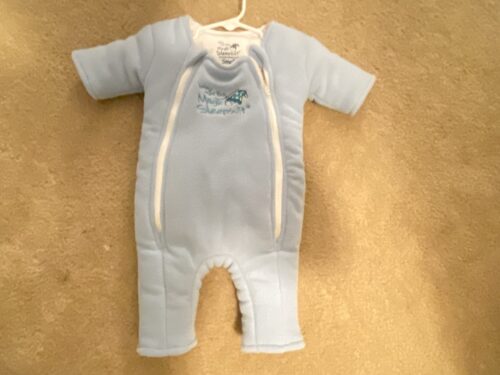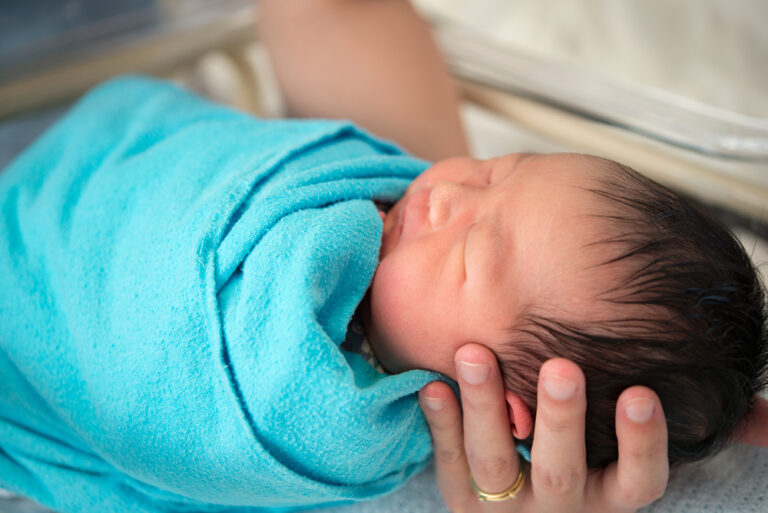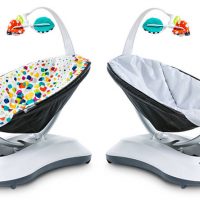As a mom of two infants who loved being swaddled, I often wondered how long that I should. Once babies become “too old” to swaddle during sleep, what are the alternatives?
Weaning your baby from swaddling may not be an easy process. Here are some tips about swaddling from experts and my own experience to help you make a safe choice for your baby.
Why swaddle a baby?
Many babies enjoy the feeling of being swaddled, meaning wrapped snuggly in a blanket or special swaddling cloth. This technique limits movement, and simulates their time in the womb or when held closely. Newborns may be comforted from swaddling while both awake and asleep.
Even after the first few weeks of life, many babies sleep better when swaddled. It prevents them from startling themselves awake due to arm movements. Plus, anything that allows babies to remain asleep can be really helpful for new parents. For more infant sleep tips, check out how to get your baby to sleep in a crib.
I learned so much about swaddling, calming measures, and baby sleep habits from The Happiest Baby on the Block. I highly recommend it! There is also a Happiest Baby DVD if you prefer visuals, or just want the basic calming recommendations without the detailed information.
Some babies, however, never feel comfort while swaddled, and that’s OK. If you feel there is no benefit, it’s perfectly fine to never swaddle your baby.
How should you swaddle a baby safely?
Blanket
Choose a blanket that’s large enough to swaddle your baby, and stay relatively snug. If your baby can kick it off, the swaddle becomes loose bedding that increases the risk of SIDS (source). It is important to monitor your baby while swaddled in a blanket.
Take care not to wrap your baby’s hips too tightly. Excessive leg pressure and spending too much time in a swaddle can cause hip dysplasia (source).
Here is how to use a blanket to swaddle a baby:
1. Put the blanket down flat with the top corner folded down.
2. Place your infant face up onto the blanket with his head above the folded corner.
3. Gently straighten one of his arms, and place it against his torso. Fold that side of the blanket over his arm and body, then tuck it snugly under the opposite arm.
4. With the second arm at his side, wrap that side of the blanket over him to tuck under the side you’ve already wrapped.
5. Loosely fold or twist the end of the blanket covers the legs, then tuck it under one side of the baby.
6. Check that you can fit a couple of fingers between the blanket and baby’s chest so it isn’t too tight. Make sure that his hips can still move.
The American Academy of Pediatrics has more tips on safe swaddling. Remember to always lie your baby on his back to sleep. While this is always important to prevent SIDS, it is absolutely essential while he is swaddled. SIDS deaths are higher for babies who are swaddled, and placed on their sides or stomachs while sleeping (source).
Swaddle sacks and wraps
Maybe my husband and I just weren’t good “swaddlers,” but our oldest daughter kicked out of her swaddled blanket on the first night we came home from the hospital. For her, it wasn’t safe to leave her in bed in a blanket wrap.
We tried several swaddle-specific blankets and sleep sacks until we found a zippered one that worked best for us. It was a SwaddlePod brand, similar to this set of two swaddle sacks.
The Love To Dream Swaddle UP seems like a good option as well. It appears to have more room for hip movement while keeping the torso and arms secure.
Simply place your baby inside the sack, and zip him in. His arms and legs should have space to move a bit, but not too much.
There are also options with velcro wings to secure across your baby, like the aden + anias Easy Wrap Swaddles. With this type, you first zip your baby inside, then secure the wings to fit over the arms and torso.
“Arms-only” wraps are also available such as the Baby Swaddle Strap, Adjustable Arms Only Wrap. This can be placed over a regular sleep sack or pajamas to wrap around baby’s arms and torso, leaving the legs free.
How long should you swaddle an infant?
Babies should never be swaddled all day. Use swaddling only for calming fussy babies, and helping them fall asleep. Infants need time during the day to move their limbs, even as newborns.
You may find that your newborn frequently requires soothing from a swaddle during the first few weeks. This will naturally decrease as he adjusts to being outside of the womb.
Knowing when to stop swaddling your baby at night is important for keeping her safe.
You absolutely must stop swaddling your baby during sleep (or any unsupervised time) when she shows signs of learning to roll from her back to her stomach. Of course, each baby achieves this milestone at a different time, but accidental roll overs may be seen as early as two months (source). At the latest, you should stop swaddling your infant by age six months.
The concern is that, if she rolls while fully swaddled, she won’t be able to lift her arms or head up or roll herself back over. This could lead to suffocation.
If your baby prefers to have her arms free while swaddled, you may still be able to give a cozy feeling by wrapping a blanket snugly around her torso, leaving her arms free. A snug fitting sleep sack is another option.
If your baby cannot yet roll over but seems uncomfortable or is sleeping poorly, it’s also time to stop swaddling. There’s no benefit of continuing to swaddle if it doesn’t calm your baby.
If you are uncertain about whether it is still safe to swaddle your baby for sleep, ask your pediatrician or family doctor. They will know the latest recommendations about safe sleep practices, and be familiar with your infant’s needs (source).
How should you stop swaddling a baby?
For some babies, it is easy to discontinue swaddling, especially they show signs of discomfort or poor sleep. You may be able to just stop “cold turkey.”
Remember that you should avoid soft bedding inside of the crib until the first birthday to help prevent SIDS (source). To keep baby warm without that swaddling blanket or wrap, try our favorite sleep sacks.
That said, other babies really enjoy the coziness of a swaddle, and have difficulty sleeping without one. Or, they may easily startle themselves awake. What do you do when it is no longer safe to swaddle them?
Not trying to roll over yet
Most infants are able to roll from their backs to bellies by age six months, but a few may master this skill early. If your baby has not yet attempted to roll, you still have time to transition them safely. One technique could be swaddle him with one arm in and one arm out. This may help him adjust to having some arm movement before ditching the swaddle altogether.
Another option might be to use a loose swaddle sack instead of a snug blanket or wrap, like SleepingBaby Poly Zipadee-Zip Swaddle Transition Blanket. Just make sure the fabric doesn’t fit so loosely on your baby that it becomes a suffocation hazard.
You could also begin the night with your baby unswaddled, then only use one if she wakes in the middle of the night. Every night or two, you can try to wait a bit longer before swaddling her.
Starting to try to roll over
If your baby is already trying to roll despite having been fully swaddled at night, it may be a bit tougher to make the transition. This was the situation we found ourselves in with at least two of our children. Sleep was “no walk in the park” even when swaddling our babies. The idea of stopping it was terrifying. For safety reasons, however, it is important to discontinue swaddling your baby at this point (source).
With my son, I moved him into a Baby Merlin’s Magic Sleepsuit. It resembles a snowsuit, and its padding restricts startle movements. With this sleepsuit, baby’s arms and legs are free, and the hands and feet extend from the ends.

For us, our baby didn’t just “magically’ begin to sleep well in it, but it worked as well as swaddling. Once your baby is consistently rolling over, however, this would no longer be a safe option. The suit’s padding may also cause your baby to become too warm which is an additional SIDS risk (source).
Another option that may reduce the startling but still allow free movement is the Amazing Baby Transitional Swaddle Sack. This swaddle sack has half-length capped sleeves. It keeps baby’s arms held close to the body, but still allows her to lift her head if she flips onto her tummy unexpectedly. Uncuffing the sleeves allows baby’s arms to be fully extended as well.
Already rolling over
But, once your baby can roll over onto her stomach, it is safest to stop swaddling her, even if it is hard for both of you.
You can try still wrapping her tummy in a snug blanket (as long as she can’t tug or kick it off). It may be better, however, to completely eliminate the swaddle, and to offer a pacifier instead (source).
Although it may be labor intensive, if using a bassinet or co-sleeper, you could place a hand on her chest as she falls asleep to prevent her from waking from sleep startles. This may not be ideal, however, if your infant has learned to fall asleep alone.
Weighted sleep sacks are also available such as Nested Bean Zen Sack – Gently Weighted Sleep Sacks. These provide comfort that is similar to weighted blankets for children and adults. While it won’t fully replicate the swaddling sensation, it may still be soothing.
Keep in mind that what you perceive as poor sleep may be perfectly normal at your baby’s developmental age. I thought my oldest was a “bad sleeper” until my middle child was born. He was worse! I then realized that my oldest had pretty normal sleep patterns. Check our baby sleep guide to learn how much sleep to expect.
Safe sleep for all babies
Whether your baby prefers to be swaddled or not, there are sleep safety rules you should know to prevent SIDS or other accidents.
- Always place your infant on her back to sleep. If she accidentally rolls onto her stomach by herself, return her to her back. Once this roll over occurs, it is time to stop swaddling your baby. By age six to seven months old, most infants can roll themselves in either direction (source). When this milestone has been achieved, it is not necessary to return your baby to a back position if rolling multiple times per night.
- If your baby happens to fall asleep in a location different from his bassinet or crib (i.e. car seat or swing), gently place him on his back, and into his bed as soon as possible. (I know. I hate this one too, but babies have died while sleeping in their car seats).
- Put baby to sleep on a firm surface like a crib or Pack-n-Play, never onto a soft surface such as a couch or nursing pillow. Do not put blankets, stuffed animals, or anything else in the place your baby sleeps (except a pacifier).
- The AAP advises against bed sharing (source). They say baby should only be in your bed to be comforted and fed when you are awake. They do, however, recommend room sharing. It is best to keep your baby’s bed in your room for at least the first 6 months, and, if possible, throughout the first year (source).
Find more details in the full list of safe sleep recommendations.






